We recently interviewed Cristina Liberati, who administers grants that support farmer cooperatives in Latin America as they improve their quality, productivity, and financial stability. Because of this project, small-scale cacao producers in rural areas can taste samples of the product they grow and assess its quality. This democratization of knowledge makes it possible for farmers to participate fully in a global market! Read the interview below to learn about how Cristina got her start in the chocolate industry, the unexpected spicy perks of international travel, and her hopes for the future of fair trade.
Q: Hello, Cristina! What is your position at Equal Exchange?
A: My position title is the Grant Projects Manager. Grant projects have been a part of Equal Exchange’s past for some time, but starting in around 2010, Equal Exchange partnered with another chocolate company, called TCHO Chocolate, in San Francisco, to apply for a grant from the United States Agency for International Development (USAID), so those are funds from the US government that are used to support projects in developing countries. And this is a multimillion dollar grant and has involved four countries in the last seven years — Peru, the Dominican Republic, Colombia, and Ecuador — and as a result of its scope and size, it’s the largest grant project that Equal Exchange has ever done.
Q: You get paid by Equal Exchange, but your work is in this sort of development realm, non-profit, aid work. Is that correct?
A: It’s a complicated question. I am a worker-owner at Equal Exchange, but for any time I spend on the grant, we actually get reimbursed by USAID.
Q: What value do you think this work has to Equal Exchange’s business?
A: Equal Exchange is a funny company in that we are a for-profit business with a social mission, and there are benefits to doing this kind of work that are not quantifiable — you can’t say “oh, well our sales tripled because we did a project in the Dominican Republic with a cacao cooperative.” But there are specific activities that we’ve done that do contribute to our commercial activities, such as improving the quality of coffee and cacao coming from particular groups, which is a clear connection to our being able to provide higher quality products to our customers. We purchase organic, and it is a major challenge for organic farmers worldwide to produce as much raw product as their neighbors who are producing with conventional methods and chemicals, so part of our project is working with small farmers to improve their productivity. Which helps us! And, finally, we work with the co-ops to improve their financial management practices. It’s always better to have a partner who is financially and managerially stable than one who is not. And unfortunately, that’s more the exception than the norm for agricultural cooperatives.
Q: What was your job before this? Your job description, which lists all your various duties, is really overwhelming! How did you get into this, how did you prepare for it, and what else have you done?
A: Before coming to Equal Exchange, I worked for TCHO Chocolate, who we partner with on the grant. I was hired there as a tour guide of the chocolate factory, and that really helped me to learn the chocolate business from the other perspective — you know, working with consumers and also having to explain production of cacao to people who know very little about it, and learning at the same time, myself. That was a great introduction into the world of chocolate. Prior to moving to San Francisco, I did go to graduate school for International Affairs, and I have lived in Latin America and studied in Latin America for a number of years. Because that’s where we primarily carry out our grant activities, knowing the language very well and knowing the culture to a certain extent helped prepare me for this work.
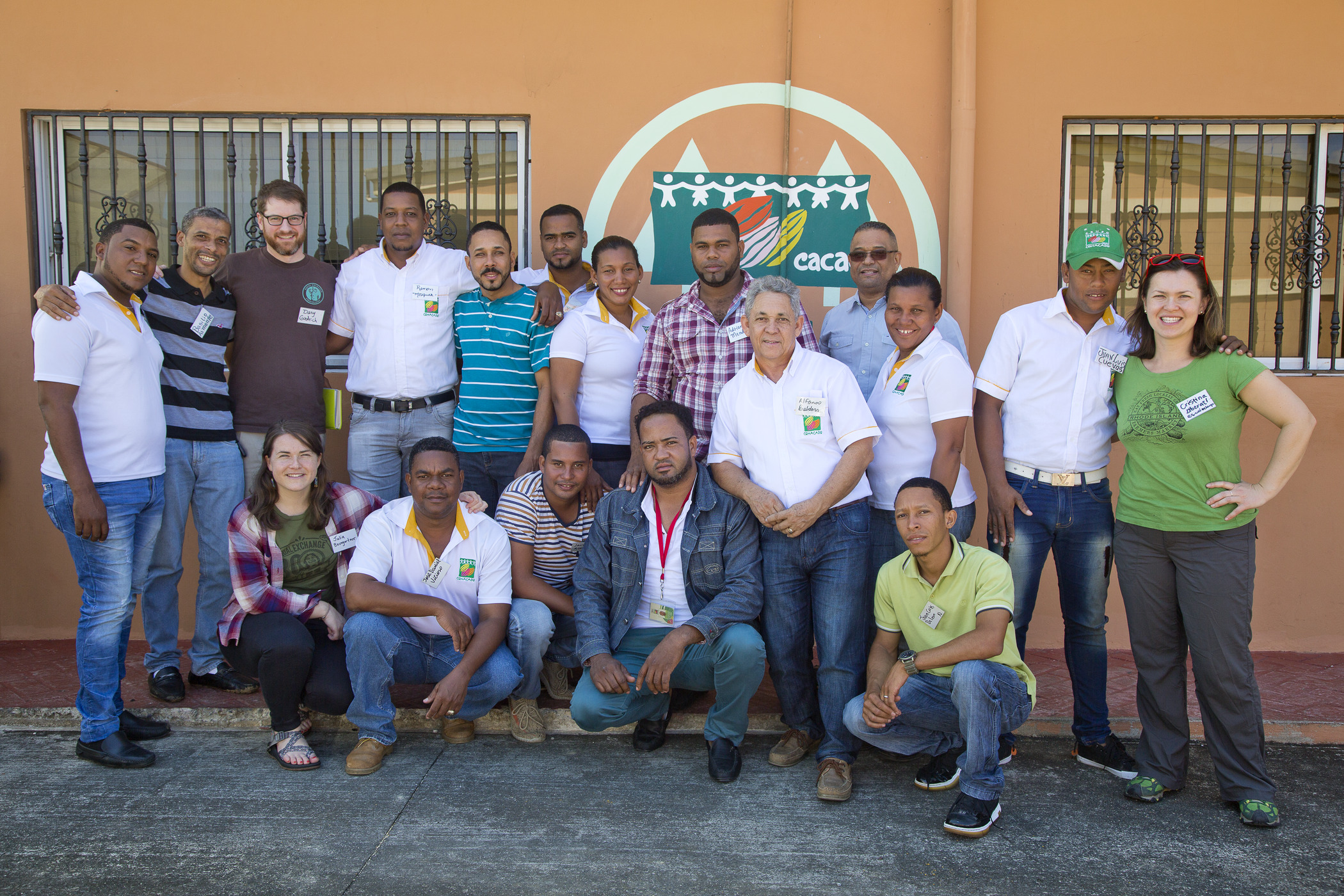
Q: The grants cover both cacao, coffee and banana farmers. All these crops may be grown in the same regions, but they’re totally different businesses. And you’re also working with project coordinators and grant consultants. What are your relationships like with all these different kinds of people? How do you balance that?
A: It’s a fun challenge, for sure. I have regular calls with each group or consultant that we work with, and that really just helps to keep on the same page of how the activities are developing. We also through our grant program helped to organize 15 different cooperative exchanges, where we brought different representatives from the farmer groups in our project together, to share information and learn about the activities they were doing and about those crops. I think my job is unique in that I get to serve as a nexus for all that information, so if I learn about how one group is, say, for example, identifying local trees with great productivity characteristics and cataloguing them, I can share — with their permission — what they’ve learned with another group who’s interested in the same type of activity.
Q: What about your traveling?
A: I travel about 30% of the year, and oftentimes what I’m doing is visiting with the cooperatives that are part of our project to see how the activities are playing out in person. Also, to troubleshoot any issues they might be having, because sometimes it’s hard to get people to talk about challenges and issues over the phone. It’s also great to just meet face-to-face with folks every once in a while. The other primary thing that we’re doing when we’re visiting our partners or these countries is holding workshops or the exchanges that I talked about, amongst different producers.
Q: Do you have trouble keeping people straight, just because there’s so many people?
A: Not really. I’ve been working with the same people now for almost seven years. The cooperative in the Dominican Republic has 10,000 members, so I don’t know everyone. But there are teams of people that I’ve worked with over and over. On farm visits, I try to visit farmers that I have met before and some that I haven’t. I always write a trip report, so I try to go back to my trip reports to refresh my memory of people’s names if I don’t see them or talk to them often.
Q: To what extent are you accountable to USAID? Who do you feel like is your boss and what keeps you accountable to this grant?
A: That answer is pretty simple. It’s the farmers that we’re trying to serve and that are our partners. We’ve been very lucky that USAID has been supportive of the work that we’ve done and of course, like anyone who offers you money, they want you to account for that properly and would like to hear about the outcomes of the use of that money, and I think that that’s fair. I also feel accountable to the worker-owners of EE that this is a good use of our time and resources as a cooperative. But I’ll stick with my first answer as to who I feel MOST answerable to.

Q: You do some quality-control work around chocolate. Is that right?
A: Yes. If I had to say I had a specialty, chocolate would be my specialty, because I did work in a chocolate factory before I came here, and it’s the crop that I know the most about, and it has been the largest focus of the grant. I’m on the Quality Control Panel at Equal Exchange, that meets once or twice a week to make sure that our chocolate is both high-quality and food safe for customers. I’m not going to complain about having to eat chocolate for my job!
Q: Equal Exchange has worked in different capacities with producers about analyzing their own products in country so that they can keep on track of whether tweaks need to be made, or how high quality their stuff is. Can you talk about that at all?
A: Sure. Beth Ann Caspersen, who’s the Quality Manager for coffee has been doing this for many years with coffee cooperatives. I do a bit more of it with cocoa cooperatives, but the ideas are the same. The way that chocolate makers analyze a sample of cocoa beans is by making it into chocolate liquor or a solid chocolate sample, and tasting it. For almost the entirety of the history of the chocolate industry, producers have been excluded from conversations about quality analysis that chocolate makers do. Through this grant and through a partnership with TCHO, we installed laboratories that would allow them to make chocolate liquor samples. And we work together with our partners to create a standardized tasting form and tools to train people to be cocoa tasters that were never publicly available before. And what these tools have allowed our partners to do is negotiate the value of their product with their clients, based on its quality. So instead of shipping a bunch of beans to a chocolate maker and then basically receiving a price from that chocolate maker that is determined by them, the producers can say, “We’ve tasted this. We know it’s worth this. And this is the price we’d like to ask you for it.” That has been a really exciting part of what we’ve done.
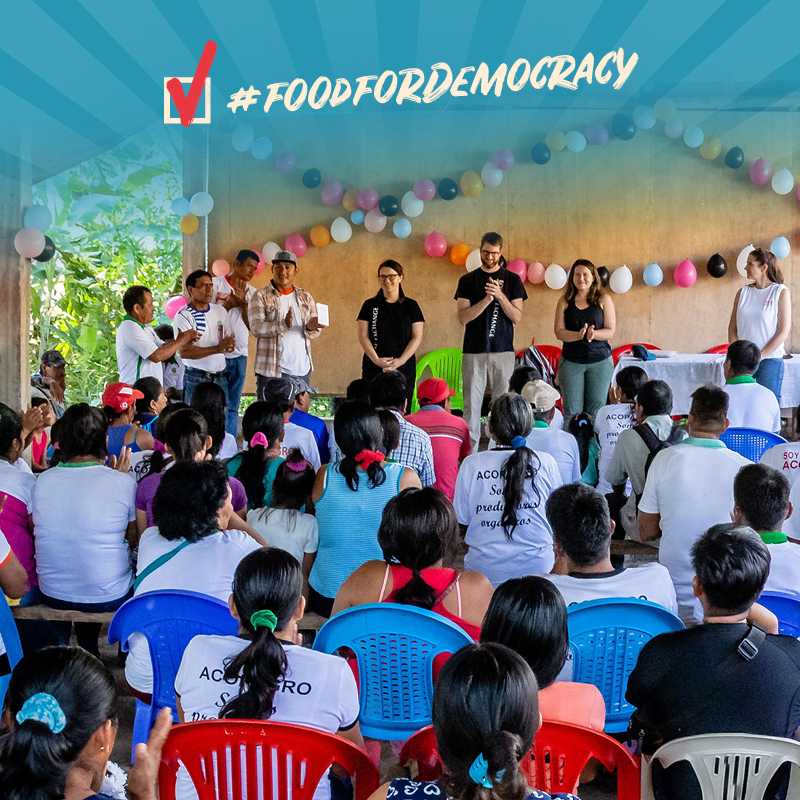
Q: What cool work stories do you have to share with us?
A: Last year, we decided to create what we call the Innovation Prize Program with our USAID grant and we were offering prizes up to $50,000 to cooperatives for new and novel ideas to tackle problems they had, either in quality, productivity, or what we call capitalization and one of the cooperatives that we work with called ACOPAGRO, based out of Peru, came to us with an idea for an irrigation program. The project manager there said to me, “You know, we’ve actually had this idea for some time, but couldn’t find funding for it, and I told my colleagues: ‘you know who we should ask about this? We should ask Cristina. We should ask Equal Exchange. Because they’ll listen to us and our idea.’” That felt really good.
Q: Did they get the prize?
A: They did get a prize!
Q: Can you tell me another story?
A: I was visiting Peru, a remote community along the riverbank of the Amazon, and the community members just had this incredible energy and were doing some wonderful things. They had formerly been coca producers for cocaine, and wanted to change from illicit crops to licit crops and were supported with growing cacao by a previous project. We went and we helped with some improvements to their fermentation area and drying area. But somehow, they found out on my first visit that I really like hot peppers. And when I came back for my second visit, they offered me a whole plate of hot peppers that they had grow specially for me to try. Which was fun, but also somewhat painful!
Q: Right, ‘cause you had to eat them all!
A: I took a few bites. I think I have a picture of that somewhere.
Q: Were they good?
A: Yeah. Oh my gosh. The food in Peru is incredible, in general. And part of it is because they know how to use those peppers!
Q: What are the lessons learned from this work?
A: I’ve seen, over the past few years, that several of our partners have had to deal with natural disasters that just seem to be more frequent and more intense every time. What I’ve learned is that the resilience of the people we work with is just truly incredible. One should never underestimate the strength, the creativity and the love for the land it takes to be a farmer. I definitely had no idea of the magnitude of that before.
Q: What’s your outlook for the future of fair trade, of farming, and of these specific communities that you have gotten to know?
A: That’s a big one. I think that fair trade or alternative trade — as a strategy and a philosophy — is more and more important every day. For me, the basis of fair trade is the relationships between the people who grow our food or produce other products, and then the people who use those products. And we do have opportunities, with technology, to connect with those people in ways that weren’t options before. But on the other hand, people continue to want cheaper and cheaper options. One of my friends told me recently that her grandparents used to spend 25% of their income on their food. Nobody seems willing to do that anymore. If people aren’t willing to pay for fair food, the farmers that we work with as it is barely get by. They do it for the love of the land that I talked about. Compounded by climate change issues, I’m not sure what that means. But people will keep eating, and they seem to not get tired of chocolate and coffee. Or bananas. So we’ve got to keep fighting to do this work the right way.
This fall, we’re posting content about Food and Democracy — and the important ways they intersect — up until the U.S. primaries on November 6th. Stay up to date by following the hashtag #FoodForDemocracy on Facebook, Instagram and Twitter!
Thank you for signing up for our newsletter!
Equal Exchange crafts chocolate with only the purest ingredients. Whether you have a soy allergy, a chemical sensitivity, or you’re simply looking to avoid soy for quality reasons, we’ve got you covered. We use 100% fairly traded and organic cacao in the form of cocoa butter and chocolate liquor. In fact, fairly traded and organic sugar and vanilla are the only other things you’ll find in our pure Dark Chocolate bars. And our Milk Chocolate and Flavored bars are also soy-free. You can enjoy all thirteen varieties with confidence.
Soy lecithin is a food additive derived from the processing of soy beans. It’s used as an emulsifier. Soy lecithin’s job in chocolate is to blend ingredients and hold things together – it keeps the cocoa butter from separating from the other ingredients.
But we don’t use it. We take the long way around for the best quality.

Premium chocolate has a glossy finish and a pleasing resistance. It melts in the mouth, but snaps when you break it into pieces. To achieve this, chocolate-makers mix the ingredients in a machine called a conche that evenly distributes the cocoa butter. The addition of an emulsifier like soy lecithin can reduce the conching time. That’s why a lot of chocolate manufacturers add it – soy saves them time and work. After conching, the chocolate then goes through a tempering process. This process arranges the molecules in a certain way before the chocolate solidifies, optimizing the texture and the taste. Because we skip that short-cut, we achieve the right smooth, balanced flavors and texture through conching and tempering alone. The process takes a lot longer, but we feel the end result is better. We get the snap – without the soy.
Learn more about our process.
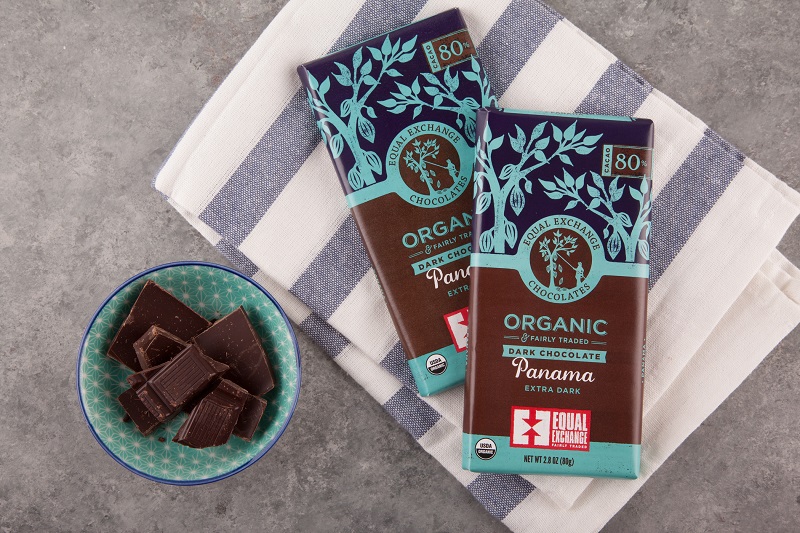
Here’s some more information to help you decide which Equal Exchange products you can safely enjoy.
Equal Exchange Organic Semi-Sweet Chocolate Chips (55% Cacao) and Organic Bittersweet Chocolate Chips (70% Cacao) are soy-free. In fact, they’re made in a dedicated allergen-free facility, with no peanuts, tree nuts, milk, eggs, soy, gluten-containing ingredients or wheat on the premises. We feel very confident recommending our chips to people with an allergy to one of the top 8 major allergens!
Our 80 gram Oeganic Chocolate Bars and Chocolate Minis do not contain soy or soy ingredients. We use organic and fairly-traded cocoa butter only, fully tempering the chocolate without adding soy lecithin as an emulsifier. Our manufacturing partner does not process soy ingredients in the facility where our bars are made.
Our Organic cocoas — Baking Cocoa and our three drinking cocoa mixes (original Hot Cocoa, Spicy Cocoa and Dark Hot Chocolate), contain no soy or soy ingredients. Though other products that contain soy are sometimes processed on the same equipment, our partners employ good manufacturing practices (GMP), cleaning the machines thoroughly between each product run.
Still have questions? Contact our helpful Customer Service Team at 774-776-7366.
Thank you for signing up for our newsletter!
when it became clear that the company was growing fast. We had many opportunities — like looking into building our own cafes, expanding the markets of our fair trade producer partners, and getting more advanced in the coffee products we were offering — but we’d have to make some big changes to take advantage of them. That is why the management at Equal Exchange proposed that we buy and move to a larger facility and build a roaster to roast our own coffee. And who was this proposal made to, you may ask? It came before the workers-owners of Equal Exchange, and in order for Equal Exchange to move forward with all these plans, the worker-owners would have to say yes, by way of a vote, by more than two thirds of the members present at the meeting this was proposed at. The good news is that in 2004, those worker-owners agreed to all three proposals (to buy, to move and to build) and we could not have grown the way we have since without those changes.
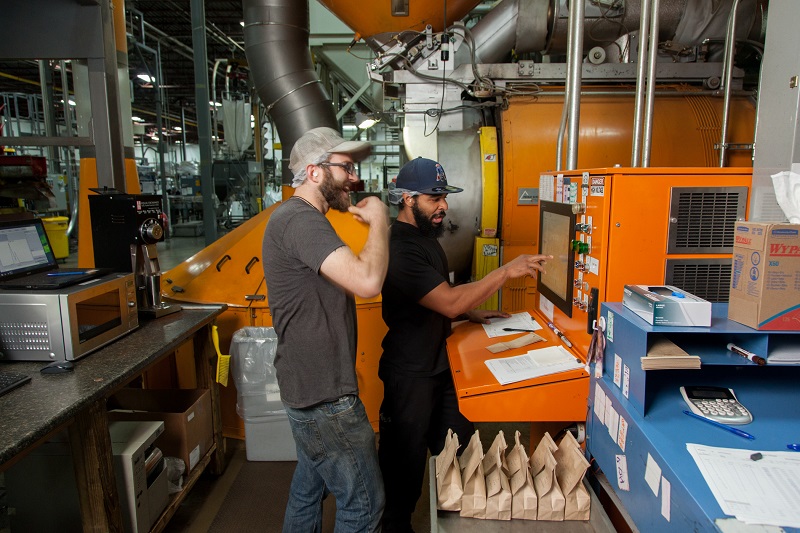
members rather than shareholders. Each member owns only one share and therefore has one vote in decisions, large or small. To say that there is a connection between cooperatives and democracy would be an understatement. All cooperatives were actually born out of the workers’ struggle for the right to vote which took place in mid-nineteenth century England. The Rochdale Society of Equitable Pioneers (now known as Cooperative UK) emerged out of that movement. Rochdale was the first successful cooperative in modern history, and is the longest running. Its founders believed that the axiom “one person, one vote” was so central that they made it a core principle in the Cooperative’s foundation. And they extended that right to both men and women, a good 80 years before woman in England were offered the same parliamentary option.
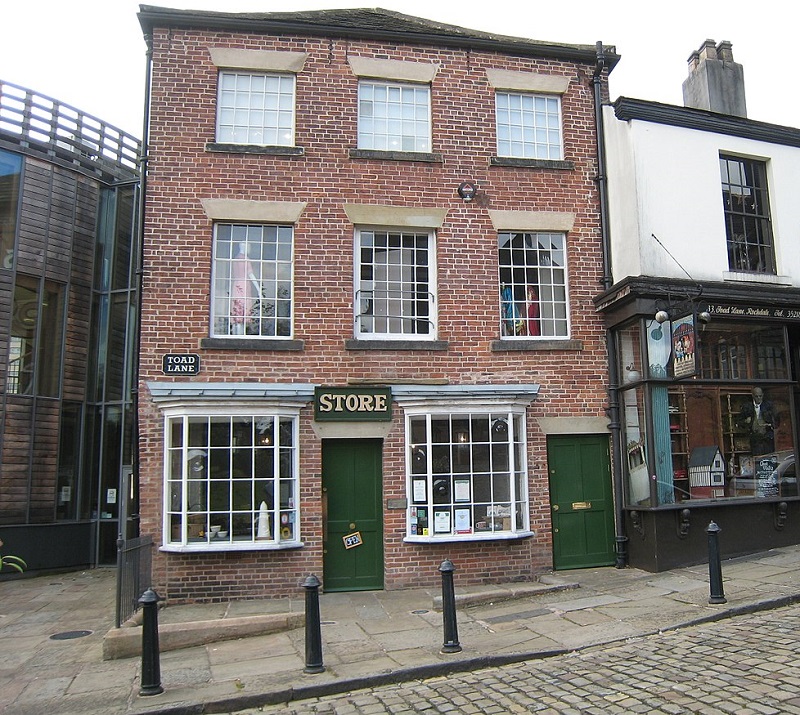
through member voting remains a central component to any cooperative, whether that be a consumer co-op, a worker co-op, or a farmer co-op. And it is this egalitarian principle that Equal Exchange values dearly – because it assures workers an equal distribution of power and voice. It’s a very powerful component of our work with our partners in producer co-ops, who had been self-organizing into democratic groups for almost 60 years before the Fair Trade movement took off.
In countries where power is concentrated in the hands of a very few, coffee, cocoa and tea farmer cooperatives offer a true democratic alternative, empowering many, and ensuring that democracy can thrive, even when faced with governments and groups who attempt to stamp it out. Each farmer, no matter how big or small their plot of land, has the same vote, the same voice, and the same power. It is important to note that due to the power that was generated by these farmers’ collectives, Fair Trade labeling organizations began to require the structure that was already in place in many parts of Latin America. Coffee farmers must be organized in democratic cooperatives in order to be officially recognized and sell their coffee as a fairly traded product. And it’s this requirement for coffee farmers that motivated the early leaders of Equal Exchange to shape the organization as a worker cooperative. If farmers organized themselves in this manner, we decided we should follow suit.
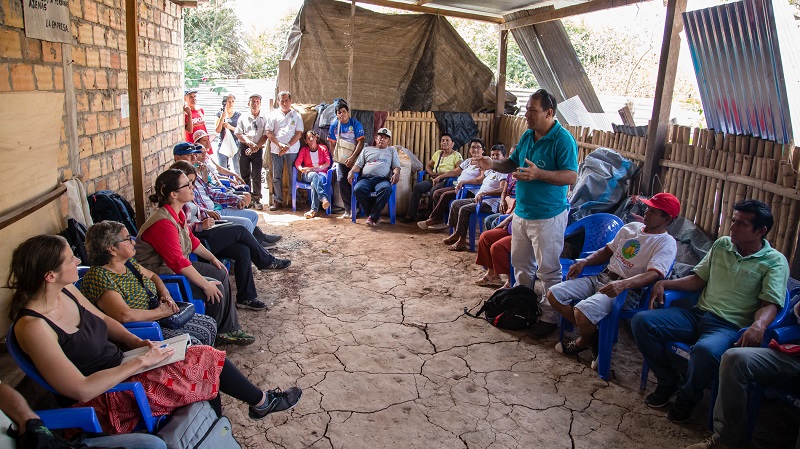
at Equal Exchange are members of a worker cooperative. All regular employees at Equal Exchange who have been here for longer than a year have to be voted on by other worker-owners to become co-owners of the organization. Each person then receives one share, and thus, one vote. Each worker gets to choose who represents the workers-owners on its board of directors. Workers serve as six of the nine board members. Therefore, in that historic vote in 2004, each worker-owner — whether their job entailed answering phones, packing boxes or overseeing operations — had the same one vote, no more and no less.
Due to our model as a co-op that purchases from farmer co-ops, and pays a fair price, U.S. food co-ops and their members made up our earliest supporters. These consumer co-ops use the same organizing structure: one consumer member, one vote, just like the Rochdale Pioneers. We owe the Equal Exchange model and the model of working with small farmer co-ops to those visionary thinkers who championed democracy through fighting for the right to vote.
This guest post was written by Aaron Dawson. Aaron was an Equal Exchange Board Member, the Treasurer of the Democracy at Work Institute, and has served on the Board of the US Federation of Worker Co-ops. He completed his Masters in Management, focusing on Co-operatives and Credit Unions at St. Mary’s University in Halifax, Canada.
This fall, we’re posting content about Food and Democracy — and the important ways they intersect — up until the U.S. primaries on November 6th. Stay up to date by following the hashtag #FoodForDemocracy on Facebook, Instagram and Twitter!
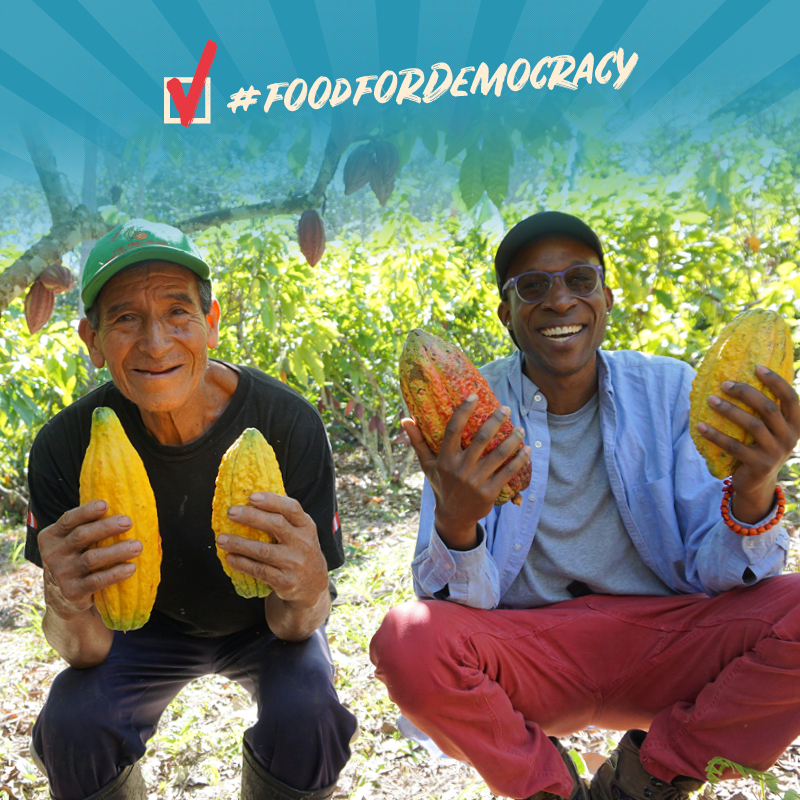
Read more about the story of the Rochdale Pioneers.
This summer, Equal Exchange brought our coffee and chocolate on the road to Austin, Texas for the 79th General Convention of the Episcopal Church. We shared a table with our partners at Episcopal Relief & Development and poured out our fairly traded brew to all comers.
Over the course of nine days, we had a lot of wonderful conversations about fair trade values, fellowship, and favorite blends! People were excited to hear about the new low price of Organic Breakfast Blend, which makes it easier than ever to serve it at church.
Here’s a mosaic of just a small sampling of the folks who enjoyed our coffee, with their names — and their thoughts — below.

Read their stories, in their own words.
1. The Very Rev. Joseph Kerwin Delicat, Dean of Holy Trinity Cathedral, Port-au-Prince, Haiti
The newly elected bishop coadjutor of the Diocese of Haiti stopped by the Episcopal Relief & Development booth to enjoy a cup of Equal Exchange coffee!
2. Carol Folbre, St. John’s Episcopal in New Braunfels, Texas
“I’m part of a Ministry of Contemplative Action (MOCA). The philosophy is to go to social action events together and then reflect. Coffee is perfect for this ministry. We use the phrase ‘sip by sip.'”
3. Captain Louis Cavaliere (U.S. Navy Retired), Grace Church, Merchantville, New Jersey
“The coffee is great and the dark chocolate is good for you!”
4. Sharon Hilpert and Ardel Hansen
These two women stopped by the booth after going by bus to show solidarity to the women at the Hutto Detention Center in Taylor, Texas.
5. Terri Bays, Church of the Holy Trinity, South Bend, Indiana
“I’m the poster child for coffee addiction.”
6. John Chilstrom, St. Matthews Episcopal, Austin, Texas
“Before the end of General Convention, I wanted to make sure I placed my first order for coffee, and I did — online!”
7. Ann Bustard, Christ Episcopal Church, New Bern, North Carolina
“My favorite Equal Exchange coffee is African Roots.”
8. Margaret Moses, Church of the Ascension, Mt. Vernon, New York
“Your coffee is delicious. It’s a nice roasted flavor which reminds me of Blue Mountain coffee in Jamaica, where I grew up. That’s why I keep coming back.”
9. Chad Brinkman and Sean McConnell, Episcopal Relief & Development staff members.
“Both of us love the Equal Exchange dark chocolate bar with Lemon, Ginger, and Black Pepper. It’s our favorite.”
10. Sarah Lawton, St. John the Evangelist, San Francisco, California
“We use Equal Exchange coffee every Sunday. It tastes really good. We have a lot of connections as a church to Central America. We know that coffee is so important to that region and we like to support farmers there.”
11. Abraham Ndungu, Trinity Episcopal Church, Columbus, Ohio
”Fantastic coffee, super chocolate.”
12. Xerxes Eclipse, Episcopal Relief & Development staff member.
Xerxes enjoys coffee and coloring at the Episcopal Relief & Development booth.
13. Timothy Kimbrough, Christ Church Cathedral, Nashville, Tennessee
“I could not have gotten through General Convention without it. It’s been my pick-me-up through the afternoon sessions. Thank you for being here.
14. Bernice Turner, St. Katherine’s Episcopal Church, Baltimore, Maryland
”I love the taste of your coffee.”
15. Alex Merritt, St. David’s Episcopal, Austin, Texas
“Episcopal Relief & Development does so much important work; it’s work that impacts some of the world’s most vulnerable people. And the coffee is delicious.”
Tea provides a taste of place – the growing region’s soil and elevation, its rainfall, the season. Cultivating it requires hard work and skill. And it’s a crop which can be vulnerable to climatic variation and environmental pollutants. That’s why we source 100% organic tea from small scale farmer co-ops. Processing and packaging steps maintain its high quality. And we want to help you learn to store and brew your tea in a way that brings out its best characteristics.
Shop Fair Trade and Organic Tea >>
Both green tea and black tea comes from the same plant. Native to Asia, Camellia sinensis thrives in tropical and subtropical climates. Our small-scale farmer partners in India and Sri Lanka know what they’re doing. Their communities have grown this crop for generations. Our partners — TPI in India and BioFoods in Sri Lanka — provide farmers with agricultural support.
When tea is produced conventionally, chemical residue can end up in the cup. Nobody wants to drink that! All Equal Exchange teas are certified organic. Instead of spraying chemical pesticides and fertilizers, our partners use natural pest deterrents, companion planting, and composting to make sure their tea plants remain healthy. These practices are better for worker safety and for the surrounding natural environment and eco-system. And we believe they lead to a high quality cup of tea.
In some parts of the world, the tea harvest is mechanized. But our partners, often located in the most remote places, continue to pluck tea by hand – selecting only two leaves and the fresh bud to ensure the finest quality. That means a human being with knowledge and experience selects each leaf that gets plucked. In our supply chain, women typically do this work.

Tea must be processed within hours of plucking to maintain its high quality. Equal Exchange tea is prepared using the orthodox method. This involves a series of precise and traditional steps focused on preserving the characteristics of the tea leaf. It’s slower than the more mechanized CTC (cut, tear curl) method, but the quality is far better. Workers wither the leaves, steam or roll them, and control the level of oxidation to determine if the finished product will be black tea or green tea. Then, they fire the leaves to halt oxidation.
View the Infographic to learn more about the steps!
When processing is complete, workers sort the tea leaves by size and grade and seal the loose leaves into large tea sacks for storage or shipment. Equal Exchange employees “cup” the tea (a process of tasting tea) and select every lot that we purchase.
Equal Exchange tea utilizes a dual-chamber tea bag for a better steep. The bag is a special blend of abaca (a relative of the banana tree family). It’s free of potential adulterants like plastic and chlorine bleach. We’ve chosen an organic cotton string that’s attached to the bag without the need for glue or a metal staple. We don’t want anything to flavor your brew but tea!

After you buy tea, proper storage and brewing techniques will help you get the best taste. Store your tea away from heat, light and moisture. When you’re ready to brew a cup, make sure to use the right temperature water for the variety of tea you’ve selected! Learn more! In this video, Equal Exchange Food Safety Coordinator D Walls demonstrates their tips for brewing green tea, black tea and herbal tea correctly:
Now that you know how our farmer partners produce and harvest this organic tea, how we prepare it for sale and how best to brew it, only one step remains. Enjoy!
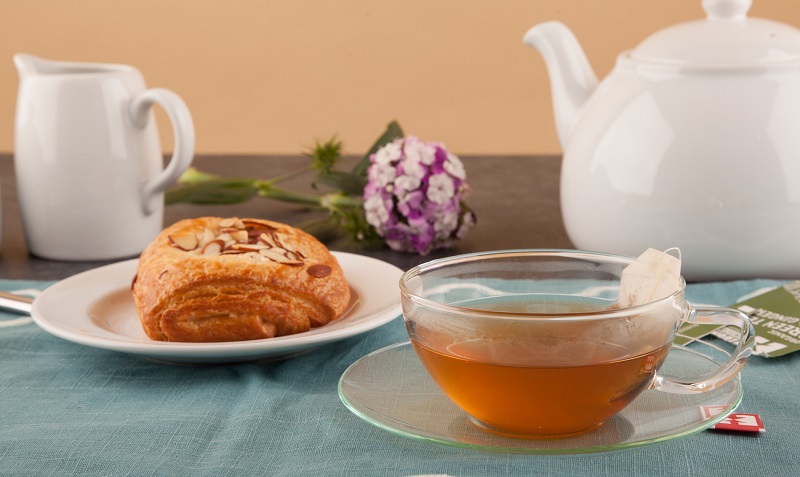
Whether you’re a longtime Equal Exchange partner or you’re brand-new around here, we’re grateful for the hard work you put into serving or selling fairly traded products from small-scale farmers. But you can’t do it alone. You need allies! You need supporters! You need other people to care as much as you do!
This blog post collects resources that will help you spread the good news to others. It’s time to celebrate your past successes and let members of your community know why purchasing ethically sourced coffee and other products is worth doing!
Does your congregation publish a weekly or monthly bulletin? This can be a great venue for reminding folks about the fairly traded products you sell or serve at worship or meetings. We’ve made it super-easy with a template you can customize. Download the Full-Color e-Bulletin digital template or the Printable Bulletin Template for photocopying.
Want to create your own from scratch? Read this inspiring example of a personalized message and adapt it for your next bulletin or email.
Not part of a faith-based group? Here’s a general, editable newsletter template you can share.
Even though you’re committed to supporting fair trade and organic foods, it can be hard to articulate its importance! If you need to provide a quick introduction to someone who’s new to the concept, consider referring to our handy talking points documents. When folks purchase Equal Exchange products, they make a choice that’s better for small-scale farmers, for the environment, and for their own health. Now you can quickly communicate how and why.
This short version (in full color) of our Talking Points can be displayed as a sign.
The longer version (black and white) is double-sided and includes more detail.
How do you explain a complicated food system? Keep these infographics on hand! They provide a simple, visual way to present facts and show the true impact of ethical trade. Now you can go deeper into the specific issues that interest you and your community the most.
See where our coffee and chocolate comes from and hear the voices of the farmers and quality professionals who make it possible. These videos will take you around the world and behind the scenes at our roasting facility — and will even teach you to brew better coffee at home! We find that they work great for presentations or as social media shares.
Watch our most popular videos here.
Or take a deep dive into every video we’ve shared (on YouTube) here.

Your work matters to everyone in our supply chains. Thanks for your support, and for getting the word out!
What have you done to tell people about why you use fair trade? What resources do you wish we offered? Let us know in the comments!
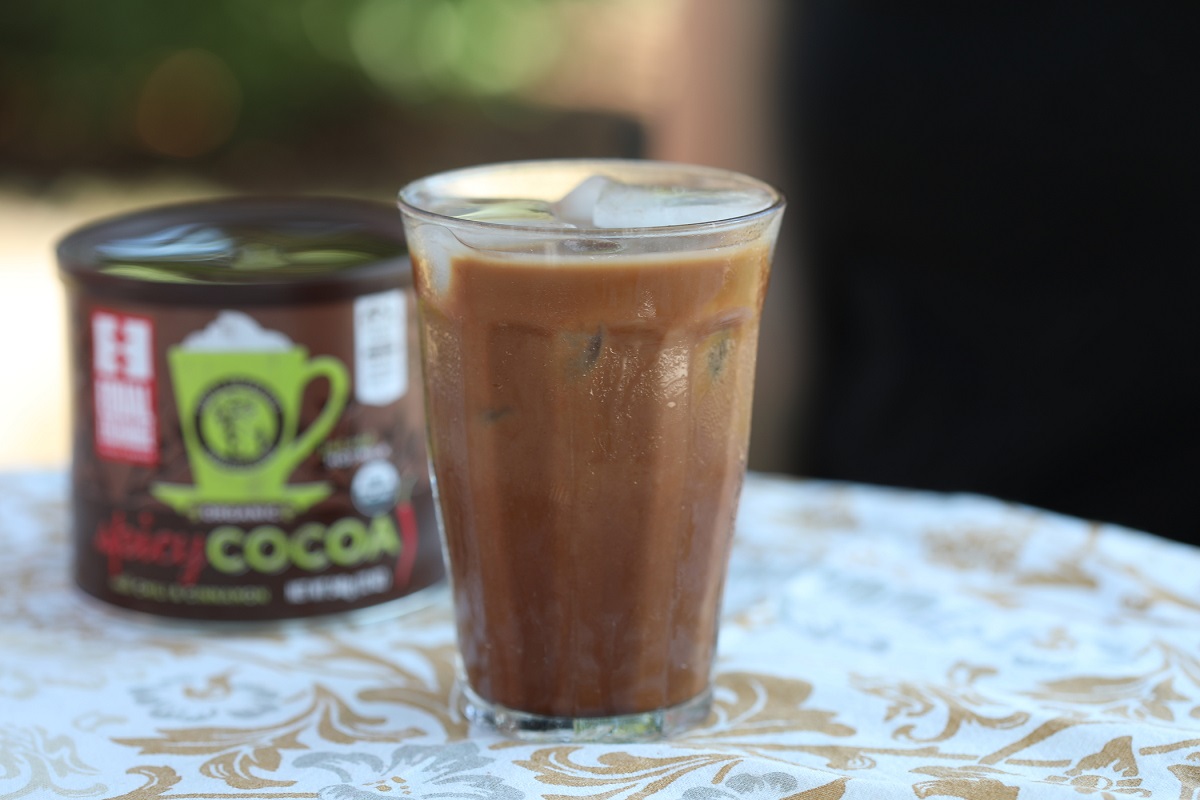


Maybe you’re searching for ideas for what to do with leftover melted chocolate from another project or dessert. Or maybe your delicious bars suffered accidental hot-weather neglect and you need a way to use up the squishy, melted results. Never fear — chocolate is wonderfully versatile. We like using chocolate molds to turn liquefied chocolate into treats with a custom look.
Let these instructions be your guide as you melt (or re-melt), temper and form it into all kinds of creative shapes, right in your own kitchen. Break out of the square and try it today!
-A mold. You can buy specially-made candy molds in fun shapes online and in many retail stores. You can also try old-fashioned muffin tins or silicone ice cube trays. Another option is to position your favorite cookie cutters on a baking sheet covered with waxed paper!
-High quality chocolate. We use Equal Exchange’s Fair Trade and organic Dark Chocolate. Chose one of our specialty bars, like Dark Chocolate Mint Crunch or Dark Chocolate Orange for extra flavor.
-A microwave.
-A microwave-safe bowl.
-A spatula.
-A candy thermometer.

Real chocolate melts at just below 100° F. After it’s melted, it must be re-tempered, so that it will set correctly and retain its sheen and snap. You can do this at home! Chop up a bar and heat it in a bowl for 30 seconds at a time in your microwave at half-power, stopping to stir every time the microwave beeps. When all the chocolate is completely melted, heat it in short bursts to bring it to 115° F. Keep track with the candy thermometer. Then, stirring the chocolate continuously, allow it to cool to 90° F.
Pour or spoon the melted the chocolate into your mold. A gentle shaking motion can help the chocolate work into corners and crevices. If you’re making lollipops, this is when you insert the stick! Twist to coat the stick to help it adhere to the chocolate, and then lay it flat in the stick-channel of the mold.
For this step, patience is required! Set your mold or baking sheet in the freezer, making sure it’s level. Your candy will be ready to pop out in 5-10 minutes, depending on the size of the mold. Wipe off any excess moisture with a paper towel and enjoy!
As with all fine chocolate, make sure to store leftovers in an airtight container in a cool, dry place.
… not that there will be any leftovers.
If you’ve mastered chocolate molds, you may like our post on Chocolate Covered Strawberries.
Or sign up for our biweekly newsletter to get all the latest fair trade recipes.
A coffee cocktail? Why not! This Cold Brew Lime Daiquiri is for the adults in the room. The berry and chocolate notes of the African coffees we recommend for the recipe pair beautifully with tart lime juice.

This cold brew cocktail can elevate your dinner party -- or help you unwind in the backyard on a hot summer day.
That was simple! Now, enjoy your Cold Brew Lime Daiquiri. Cheers!
Post a picture of yourself in the Great Outdoors with your favorite Equal Exchange beverage or snack and tag it #eeoutdoors — you could win one of four prize packs worth $50 each!
We think a strong connection to nature is healthy! That’s why we source our coffee, tea, chocolate and other products from people who farm using sustainable practices. What do YOU do to show your appreciation for the world outside four walls?
A picture speaks a thousand words. Whether your backyard is a desert or a rainforest, whether you like to kayak or prefer croquet — we want to see it! This summer, share your epic adventures with EE by entering our Instagram contest!
.
Here’s how to win. First, follow @equalexchange. Then post to Instagram by 8/31/18, using #eeoutdoors! Entries must depict you doing an outdoor activity that you love, with an EE product in the shot.
We’ll award prizes to the two posts with the most likes. And our editors will pick our favorites and award prizes to them, too. That’s FOUR chances to win! Check out #eeoutdoors on Instagram to see the posts!
.
The fineprint:
Equal Exchange is the administrator of this promotion. It is not sponsored, endorsed or administered by, or associated with Instagram.
We must receive your entry by 11:59 PM EST on 8/31/18. By entering, you affirm that you are 18 or over and a US resident. EE employees are not eligible to win.
Photos must have been shot outdoors and must contain an EE product to be considered. Entries must tag @equalexchange and use the contest hashtag. EE reserves the right to disqualify any entry deemed offensive, inappropriate or otherwise unsuitable.
Two winning entries that adhere to the rules will be chosen based on likes. An impartial jury of EE staff members will choose two additional entries that adhere to the rules. We’ll contact winners by direct message on Instagram. Winners will have one week to claim their prizes by providing a US mailing address (not a PO box). We’ll ship prizes via UPS Ground.
We’ll announce the winners by 9/10/18.
At Equal Exchange, we work hard to bring you organic, sustainable and fairly traded coffee, tea and chocolate. What do we do when we’re not doing that? Let us show you!
EE worker-owners from every region of the US sent in pictures of ourselves, our friends and our family members (and our dogs!) spending time in the Great Outdoors. For some of us, that means a long hike or an ambitious workout. Others would rather dig in our gardens, relax by the shores of an inviting lake, or hunt for bugs in the backyard.

Share a pic that captures YOUR epic nature adventures and love of fair trade on Instagram. We’re giving out prizes! Read the contest post for details.
As our co-op has grown, we’ve become a far-flung group of people who work out of offices all over the country. You’ll notice different kinds of scenery in the background of these snapshots. But one thing we have in common is that we care about the impact our business has on the natural world. We want to make sure Equal Exchange is environmentally responsible. We strive to build supply chains that are fair to people and respectful of the earth.
EE supports growing methods that are better for the environment. Small-scale, diverse farming may not be as efficient as huge, monocrop plantations. But small farms and cooperatives are more sustainable in the long run — economically, socially, and for the natural world that surrounds us.

Thanks for doing your part by shopping for organic and fairly traded foods. And thanks for taking the time to explain to your friends, family and coworkers why it matters. Sound ecological practices are everyone’s responsibility.
Not sure what to say? We’ve got you covered with Fair Trade talking points.
When we feel a connection to nature, we’re more likely to make an effort to protect it. That’s why Equal Exchange worker-owners are all about getting out — wherever we may be — to have an adventure. We hope to see you there!
Photo credits:
Collage 1 clockwise, from top left: Ashley Krant at Badlands National Park in South Dakota; Liza in Vermont (photo by Megan Chisholm); a friendly snail (photo by Jill Taylor); Marlon Cifuentes in Providence, Rhode Island; Laura Bechard with Apuka the dog in New Hampshire (photo by Erika Szonntag)
Collage 2 clockwise, from top left: Jeff Purser at Songo Pond in Maine; Cutch the dog at Mount Hood in Oregon (photo by Stephanee DiMaggio); Marcus Jones in Oregon (photo by Stephanie O’Rourke); Andrew, Alison, Vinnie and Louie Booth-Gribas at Ballard Locks in Washington (photo by Vera Pash); Zumwalt Prairie in Oregon (photo by Katie Sharpe).
Collage 3 clockwise, from top left: Evan at Diana’s Baths in New Hampshire (photo by Jill Taylor); an EE cup in Michigan (photo by Ravdeep Jaidka); Dave Tybor, Rachel Tybor and Lucas Fowler at Kelly Park in Florida; Shawn Seebach at Dog Mountain in Washington; Ned the dog with Emily Nink, Hannah Bassett and Meghan Bodo in New Hampshire (photo by Ian MacLellan).
Sweet Tea is the summer drink of choice across the American South. As the days heat up, it’s time to get your tea game on-point!
EE Sales-Rep LeeAnn Harrington is a professionally trained chef. In Texas, where she hails from, folks sip their iced tea without sugar. But during the five years LeeAnn spent in Orlando, FL studying at LeCordon Bleu, she developed a sweet tooth and learned to drink Sweet Tea like a local.
Chef LeeAnn is a perfectionist; when we asked for Sweet Tea tips using fairly-traded teas, she told us she’d have to experiment a bit. She’s been interested in the science of cooking since childhood, when she made her first pudding from scratch, marveling as the ingredients thickened from a watery liquid to a rich, velvety texture.
True to form, Chef LeeAnn tweaked her Southern Sweet Tea recipe until she achieved just the right blend of flavorful and refreshing.

Here are Chef LeeAnn's instructions for black tea, green tea and herbal tea. Try all three versions for peak summer chill!
Combine the granulated sugar with two cups of water in a medium-sized saucepan and heat over medium heat, stirring continuously with a large spoon until the sugar is completely dissolved. Set aside to cool.
Over medium heat, bring another saucepan with four cups of room temperature water to 212 degrees F, or just to boiling, (not a rolling boil).
Remove from the heat, and place the 6-8 bags of tea in the saucepan. Cover with a lid and let the bags steep for 4-5 minutes.
Remove the tea bags and let the brewed tea cool to room temperature. Leaving the bags in for much longer than five minutes can result in a bitter taste!
When both mixtures are at room temperature, combine them in a gallon size container and add the remaining 10 cups of water.
Place in the refrigerator for at least eight hours to allow the tea to cool sufficiently.
Variations on this theme:
Try substituting Equal Exchange Organic Green Tea! Bring the water to boil, then let cool to 170-180 degrees and steep for just 2-3 minutes before removing tea bags and continuing with the recipe as written above. Or use a caffeine-free Organic Herbal Tea from Equal Exchange such as Rooibos, Peppermint, Ginger or Chamomile. Bring the water to boil, 212 degrees F. Immediately add teabags, but steep for longer, 8-10 minutes.
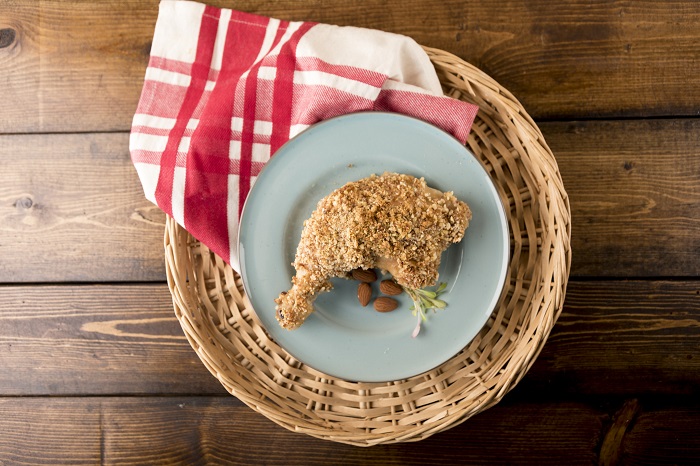
Fairly traded and organic almonds give this crispy chicken dish extra texture and a mildly sweet, nutty flavor, complimented by black pepper and paprika. Our Almond Crunch Chicken recipe is just as easy to make gluten-free. Grill it or bake in the oven for a crowd-pleasing summer recipe.
Enjoy!
Hungry? Read more picnic recipes!
Want to receive more news and ideas for fairly traded products? Sign up for our newsletter!
Do you enjoy a hot cup of coffee in the morning as much as we do? Do you love red meat? Then you’ll flip for our BBQ Spice Rub recipe.

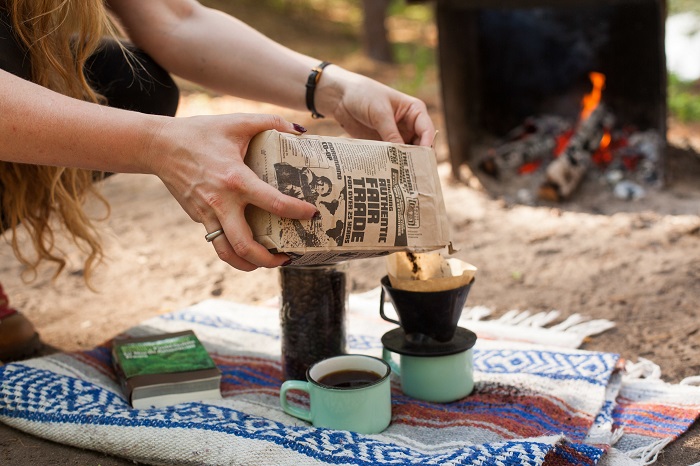
Hungry? Read more picnic recipes!
Thank you for signing up for our newsletter!
In early spring, gardeners in the USA welcome warmer weather by pouring over our seed catalogs, readying the soil in our plots, and starting plants indoors. By June, we’ve moved those seedlings outside. We’re beginning the rounds of weeding and watering that will lead to bountiful harvests in the summer and fall. If gardening’s your hobby, burying your fingers in the damp, rich soil (and later, scrubbing that dirt out from under your fingernails!) can help you feel a connection to the people who grow coffee.
Across the world, coffee farmers are hard at work, too. But Coffea arabica has a multi-year growth cycle. Its rhythm of cultivation is different from the vegetables we’re used to tending. A tomato or zucchini plant bears fruit all summer before dying. We save its seeds or buy new ones next year. Farmers who grow coffee invest more deeply. Each plant takes years to mature.
Coffee begins its life in a nursery. After about a year, when a plant has reached 18 to 24 inches tall, it’s hardy enough to be replanted on a farm. But it won’t begin to produce until it reaches age four or five. Flowers cover the branches of the mature coffee plant and release a jasmine-like scent. Six to nine months later, fruit – called coffee cherries because of the similar size and shape — appears. Each cherry holds two seeds. These are the coffee beans! As the cherries ripen, they change in color from green to yellow, then to dark orange or deep red.
Farmers must tend their plants carefully to ensure good yield. And when they get old, they won’t produce reliably. If diseases like La Roya affect the plant, the farmer must replant sooner. This renovation is expensive for small-scale producers, but necessary.

Because coffee requires a warm climate to grow, spring doesn’t mean the same tasks for farmers in the Coffee Belt as it does for us. Coffee thrives in tropical and subtropical climates, usually 1,000 miles from the equator or closer. But that doesn’t mean the crop ripens at the same time in all countries that grow coffee. Generally speaking, higher altitudes mean a cooler climate, deferring the cherries’ readiness.
The beginning of the harvest season yields a small amount of coffee with a flavor that isn’t optimal. Most coffee ripens during the middle of the harvest. Then, the end of the harvest brings the leftovers. Because Equal Exchange has longstanding relationships with growing cooperatives, we can buy high-quality coffee that’s ripen enough to have acquired its most refined and mature flavor.
We talked to Todd Caspersen, our Director of Purchasing and Production, for better insight into what coffee farmers are up to at this time of year. He says:
“As you plant your summer garden, our producer partners in Central America are finishing up their export season, shipping last containers and doing the accounting of the 2017/2108 crop. Farmers will now turn their attention to pruning, fertilizing, replanting and weed control. In Peru and Bolivia, farmers have begun harvesting and will be doing the meticulous work of harvesting ripe cherries, processing and drying the beans that will be exported starting in August.”
If you’ve ever grown anything, you know it’s not exactly instant gratification. We choose to do it because we enjoy the steps in the process! Our gardening efforts protect something incredibly delicate and vulnerable until it flowers, matures and produces.
For crops like coffee, the maturation of the fruit is still just the beginning. Producers must pick the cherries by hand, then de-pulp, ferment, dry and sort them before the green beans are finally ready to be shipped. Those who grow coffee are highly-skilled professionals. Their hard work humbles us. That’s why Equal Exchange commits so firmly to trading directly and paying a fair price for every harvest.
This spring, we hope you’ll enjoy every task you undertake in the garden or flowerbed. We hope you’ll recognize all you have in common with people around the world who grow coffee and make their living from the land. And we hope when you brew a cup of fairly traded, Organic coffee or enjoy a glass of cold-brew afterward, you appreciate it fully!
Thirsty? Shop for equitable coffee sourced from our small-scale farmer partners.